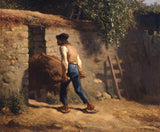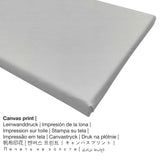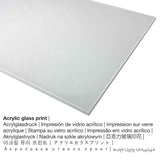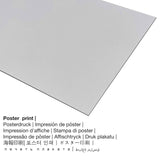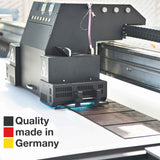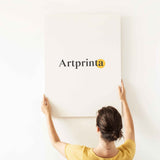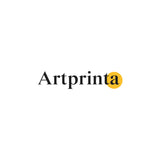Jean-François Millet, 1848 - Onye ọrụ ugbo nwere wheelbarrow - mbipụta nka mara mma.
Ụtụ gụnyere. Mbupu gbakọrọ na ndenye ọpụpụ.
What does the website of the Indianapolis Museum of Art say about the artwork from the painter Jean-François Millet? (© - Ụlọ ihe ngosi nka nke Indianapolis - Analọ ihe nkiri nka nke Indianapolis)
Millet was a leading member of the Barbizon School of painters, which rose to prominence around 1850. Often working directly from nature, these artists devoted themselves to painting landscapes in the vicinity of the village of Barbizon and the forest of Fontainebleau, where Millet moved in 1849.
Nkọwapụta ngwaahịa zuru ezu
Ihe karịrị afọ 170 masterpiece Peasant with a Wheelbarrow e sere ya nwoke onye na-ese ihe Jean Francois Millet. The 170 years old version of the piece of art has the following size 17-7 / 8 x 14-7 / 8 na. Mmanụ na kwaaji was applied by the painter as the technique for the artwork. Furthermore, this artpiece is in the the digital collection of Indianapolis Museum of Art, which is one of the finest universal art museums that has an extensive collection of art history from different eras with objects from all parts of the world.. With courtesy of - Analọ ihe nkiri nka nke Indianapolis (ikikere: ngalaba ọha).The creditline of the artwork is the following: . Moreover, alignment is landscape with a ratio of 1.2: 1, nke pụtara na ogologo bụ 20% ogologo karịa obosara. The painter Jean-François Millet was a European artist, whose artistic style can be attributed mainly to Realism. The Realist artist lived for a total of 61 afọ, amuru na afo 1814 and died in 1875 in Barbizon.
Họrọ ihe ebipụta nka kacha amasị gị
Maka mbipụta nka ọ bụla anyị na-enye ihe dị iche iche & nha. Nhọrọ ndị a dị maka n'otu n'otu:
- Ebipụta akwụkwọ mmado na ihe akwa akwa: The poster print is a printed cotton canvas paper with a slight structure on the surface. It is ideally suited for framing the art print in a personal frame. Please keep in mind, that depending on the size of the poster we add a white margin of around 2-6cm round about the work of art in order to facilitate the framing.
- Ugogbe acrylic ebipụtara: The acrylic glass print, which is sometimes referenced as a plexiglass print, will turn your favorite original work of art into brilliant home décor. The artwork will be printed with state-of-the-art UV direct print machines. The great benefit of an acrylic glass fine art copy is that contrasts and also artwork details become more identifiable with the help of the very fine tonal gradation in the print.
- Kwaaji: The printed canvas stretched on a wooden stretcher frame. It makes the special look of three-dimensionality. How do I hang a canvas on the wall? The advantage of canvas prints is that they are relatively low in weight, which implies that it is quite simple to hang up the Canvas print without any wall-mounts. Hence, canvas prints are suited for all types of walls.
- Mbipụta aluminom (aluminium dibbond): These are metal prints on aluminium dibond material with an outstanding depth. A non-reflective surface make a fashionable look. For your Direct Print On Aluminum Dibond, we print your favorite artpiece right onto the aluminium composite white-primed surface. This print on Aluminum Dibond is one of the most popular entry-level products and is a truly contemporary way to showcase art reproductions, as it puts the viewer’s attention on the replica of the artwork.
Ozi ndabere izugbe na onye na-ese ihe
| aha: | Jean Francois Millet |
| Gender: | nwoke |
| Obodo onye nka: | French |
| Ọrụ: | onye na-ese ihe |
| Country: | France |
| Nkewa onye nka: | omenkà nke oge a |
| Ụdị nka: | Ihe ngosi |
| Oge ndu: | 61 afọ |
| A mụrụ: | 1814 |
| Afọ nwụrụ: | 1875 |
| Obodo ọnwụ: | Barbizon |
Data ndabere gbasara akụkụ nka mbụ
| Aha eserese: | "Peasant with a Wheelbarrow" |
| Nhazi nka nka: | sere |
| Category: | nkà nke oge a |
| Time: | 19th narị afọ |
| Afọ okike: | 1848 |
| Afọ nka: | ihe dị ka afọ 170 |
| Usoro nka izizi: | mmanụ na kwaaji |
| Nha ihe osise izizi: | 17-7 / 8 x 14-7 / 8 na |
| Ụlọ ihe ngosi nka / mkpokọta: | Analọ ihe nkiri nka nke Indianapolis |
| Ebe ngosi nka: | Indianapolis, Indiana, Njikota Obodo Amerika |
| Weebụsaịtị nke ihe ngosi nka: | Analọ ihe nkiri nka nke Indianapolis |
| Ụdị nka nka: | ngalaba ọha |
| Site n'aka: | Analọ ihe nkiri nka nke Indianapolis |
Nkọwa ihe ahaziri ahazi
| Nkewa edemede: | ezi nka mmeputakwa |
| Usoro mmeputakwa: | dijitalụ mmeputakwa |
| Usoro nhazi: | Mbipụta UV ozugbo (mbipụta dijitalụ) |
| Mmalite ngwaahịa: | arụpụtara na Germany |
| Ụdị ngwaahịa: | mmepụta ihe na-achọ |
| Eji ngwaahịa a chọrọ: | foto mgbidi, mma mgbidi |
| Ndepụta: | nhazi odida obodo |
| Oke akụkụ: | 1.2: 1 ogologo ruo obosara |
| Ntụgharị nkọwa akụkụ onyonyo: | ogologo bụ 20% ogologo karịa obosara |
| Ihe mmeputakwa dị: | Mbipụta kwaaji, mbipụta enyo acrylic (nwere ezigbo mkpuchi iko), mbipụta akwụkwọ mmado (akwụkwọ kwaaji), mbipụta ọla (aluminium dibbond) |
| Nhọrọ nha nke akwa akwa n'elu etiti ihe na-agbatị (mbipụta kwaaji): | 60x50cm - 24x20" |
| Mpempe iko acrylic (nwere ezigbo mkpuchi iko) nha: | 60x50cm - 24x20" |
| Ụdị akwụkwọ mmado (akwụkwọ kwaaji) dị iche iche: | 60x50cm - 24x20" |
| Mbipụta aluminom (ihe alumini debond ihe): | 60x50cm - 24x20" |
| Nhazi mbipụta nka: | ngwaahịa anaghị emebi emebi |
Ederede iwu: We try all that we can in order to depict the art products in as much detail as possible and to showcase them visually on the different product detail pages. Nevertheless, the tone of the printing material and the printing may vary to a certain extent from the presentation on your screen. Depending on the screen settings and the condition of the surface, color pigments may not be printed as exactly as the digital version on this website. Considering that our art prints are printed and processed manually, there may as well be slight deviations in the size and exact position of the motif.
© Nchekwa ikike nwebisiinka - www.artprinta.com (Artprinta)

